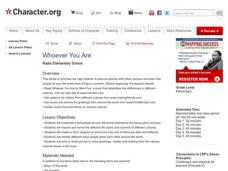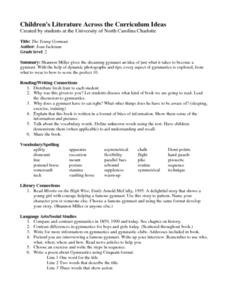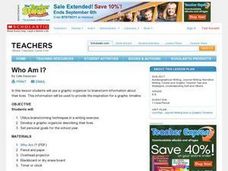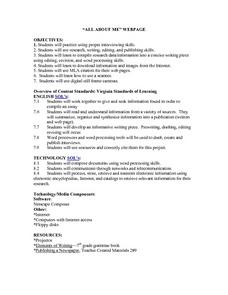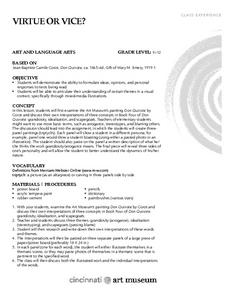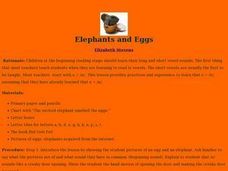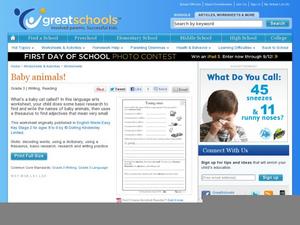Curated OER
King Bidgood's in the Bathtub
students add their own scenarios to the book using the same rhythmic pattern. Students describe what is happening in the picture as a class shared writing activity. Students discuss reasons why the people in the kingdom were upset that...
Curated OER
Mural Mania
Learn about your home state. After listening to stories about your state, identifying symbols, and discussing what makes your region special, your class creates a mural.
Curated OER
Owl Eyes.
Students create an animal with clay and use toothpick to draw or carve features. Students write descriptions of their animal and tell why they created it in a certain way. Students write legends on their own, perhaps using their created...
Curated OER
Gingerbread Baby's Point of View #8
Read the story Gingerbread Baby and use these various activities to connect to grammar, art, and point of view. In one activity, learners create character masks. They practice writing verbs on the back of the masks to tell what each...
Curated OER
Feelings From A to Z
Third graders create a class A to Z Feelings book to explore emotions, discover new words, pose for a "feeling" icture, and write about the feeling.
Curated OER
Whoever You Are
Students examine cultures, traditions, and feeling throughout cultures. In this cultural lesson, students use literature, maps, and cultural information to examine how people have universal feelings despite their different cultures and...
Curated OER
100th Day Celebration
Students celebrate the 100th day of school with a variety of math and language arts activities based on the number 100. They make books, count objects, and draw their predictions about life 100 years from now. They also estimate the...
Curated OER
Teaching With Pourquoi Tales
Students read and discuss several Pourquoi tales--legends that explain why certain natural events occur. They complete a variety of activities surrounding each tale and then write their own Pourquoi tale.
Curated OER
Red Leaf, Yellow Leaf
Students discuss the differences between a storybook and an information book. Students use various materials found in nature to make a nature collage. Students make a nature dictionary using pictures and their own definitions from the...
Curated OER
Flat Stanley Visits....Your Imagination in Claymation!
In this literature activity, young scholars read the Jeff Brown book Flat Stanley and collaborate to create claymation characters from the story. Students create a claymation video and discuss using word cards during hte movie.
Curated OER
Idioms in Everyday Language
Students create an iPhoto book exhibiting a variety of idioms that describe feelings. They take photos using a digital camera that show students exhibiting the feelings explained by the idioms.
Curated OER
For the Fun of It
Students view pictures of Amelia Earhart and discuss the social and historical context of her life. They read excerpts of Earhart's autobiography "The Fun of It" and analyze her purpose in writing it.
Curated OER
The Faithful Friend
Students work in co-op groups to create a Reader's Theater production of the story. Students create a flow map that sequences the major events in the story. Students research the island of Martinique and create a travel brochure...
Curated OER
The Young Gymnast
Second graders compare and contrast gymnastics in 1859, 1900 and today. Students contrast differences in gymnastics for boys and girls today. Students pretend that they are interviewing a famous gymnast and write up their interview....
Curated OER
Officer Buckle and Gloria
Students write a class letter to a local policeman asking him to come and talk to the class and create a list of safety tips as a class. Students research information on police dogs: type of dogs used, where they come form, how they are...
Curated OER
Who Am I? - Brainstorming
Students brainstorm lists of places, events and relationships that define them. They search for clip art and pictures in magazines to illustrate the items on their list and create a graphic timeline of their lives.
Curated OER
Character Baseball Cards
Create baseball cards for literary characters with this lesson plan. It introduces young scholars to baseball cards, their components (stats, picture, etc.), and prompts them to draft and publish their own cards based on figures from...
Curated OER
"All About Me" Webpage
Students conduct interviews and write about the interview. The information from these interviews is used to create a webpage on Netscape Composer. Students cite Internet sources for any images downloaded from the web. Students also use...
Curated OER
Virtue Or Vice?
Students create triptychs, pictures in three panels side by side, of certain themes displayed in the painting "Don Quixote" by Jean-Baptiste Camile Carot. Student evaluations are accomplished through participation during in-class...
Curated OER
The Wetlands
Complete a comparison of the wetlands found in New York and Louisiana. Using various research methods, gather data on the wetlands found in New York and Louisiana, the animals, conditions, etc. Data is used to create a brief report on...
Curated OER
Creature Feature Poetry Keyword Search!
Young scholars examine the differences between fact and opinion, and brainstorm ideas for a keyword list by analyzing facts. They listen to poems, and create posters listing three keywords about each creature featured in the poetry.
Curated OER
Elephant Eggs
Study the short and long sounds of the letter e. Learners will practice words and tongue twisters using both the short and long vowel /e/. They use letter boxes and letter tiles to spell words containing the target sound. To close the...
Curated OER
Career Education for Early Elementary Grades
It's never too early to connect children with the real world meaning of their work. A series of four one-hour sessions, plus a field trip, make up this unit on college and career readiness for first and second graders. After viewing a...
Curated OER
Young Ones
This is the cutest reference materials activity ever! Researchers complete six sentences on baby animal names, continuing the pattern by writing five more sentences about other animals from their research. They use a thesaurus to look up...





